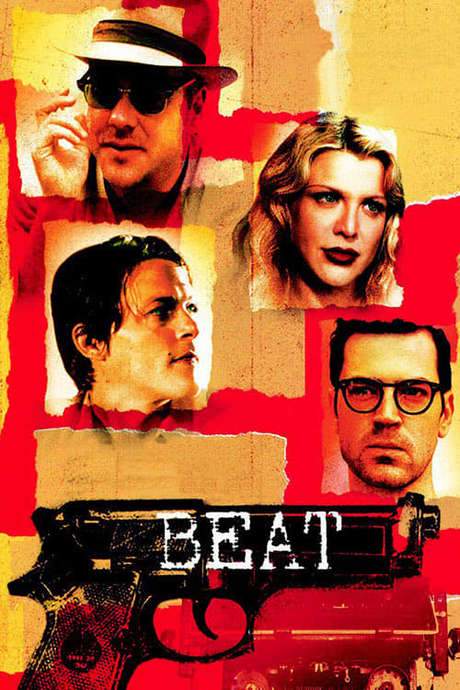
Beat
Year: 2000
Runtime: 93 mins
Language: English
Director: Gary Walkow
Set against a backdrop of sex, drugs and early rock‑and‑roll, the film dramatizes the true story of two murders that profoundly affected a group of college friends. Their lives would later intersect with the rise of the Beat Generation, producing some of its most influential writers.
Warning: spoilers below!
Haven’t seen Beat yet? This summary contains major spoilers. Bookmark the page, watch the movie, and come back for the full breakdown. If you're ready, scroll on and relive the story!
Beat (2000) – Full Plot Summary & Ending Explained
Read the complete plot breakdown of Beat (2000), including all key story events, major twists, and the ending explained in detail. Discover what really happened—and what it all means.
In 1944 New York City, beat writers and students Allen Ginsberg Ron Livingston, Jack Kerouac Daniel Martínez, Lucien Carr Norman Reedus, William S. Burroughs Kiefer Sutherland, and David Kammerer Kyle Secor all become acquainted with Joan Vollmer Courtney Love, a student at Barnard College. Joan and William begin a romance that draws these young writers deeper into a web of friendships, rivalries, and unspoken desires. David Kammerer [Kyle Secor] becomes entangled in a volatile confrontation with Lucien Carr, culminating in a fatal act of violence after a dispute over unwanted advances in a park. Lucien Carr’s confession to the murder—noting that David had an obsession with him—lands him with two years in prison, setting a somber tone for the group’s volatile dynamics.
By 1951, Joan and William are married and living in Mexico City with their young son, William Jr., and Julie, Joan’s daughter from a previous marriage. Joan’s discontent simmers beneath a carefully curated life, while William continues an affair with a male lover, Lee Sam Trammell, whose secrecy gnaws at the edges of their relationship. William’s trip to Guatemala to see Lee undercuts any sense of stability, as Lee remains evasive and distant, suggesting that William’s affections may be more performative than reciprocated.
When Allen and Lucien arrive in Mexico City, Joan and Lucien reconnect and Joan lays bare her unhappiness with her marriage. The trio—Joan, Lucien Carr, and Allen Ginsberg—plan a weekend excursion to visit the Parícutin volcano, while William returns from his trip to Guatemala and confronts the fragility of his own marriage. He has learned that Lee’s affection does not always translate into closeness, and this tension colors the upcoming journey.
On the road through rural Mexico toward Parícutin, the atmosphere grows tense with unspoken desire and competing loyalties. Allen tries to persuade Joan to abandon William and return to the United States with him and Lucien, but Joan refuses to leave William despite her unhappiness, sensing in him a potential she fears she might never fully recover. She is haunted by the possibility that returning to the U.S. could expose William to dangerous legal trouble linked to heroin possession, a fear that keeps her tethered to a life she finds increasingly unfulfilling.
As the journey continues, sexual tension between Joan and Lucien intensifies, though she resists his repeated advances. The.group returns to Mexico City, and Lucien and Allen urge Joan to relocate with them, offering a fresh start and a chance to escape the pressure and heat of their complicated lives. Joan remains stubbornly loyal to William, a choice that keeps the trio in limbo and intensifies the ache beneath the surface of their friendships.
William finally returns from Guatemala and the couple discusses separation, yet the possibility remains unresolved. A breakdown on the road soon follows: Lucien Carr’s car breaks down near the Texas border, leaving him to hitch a ride back to New York, where he must report to his new assignment at United Press International. In Mexico City, Lee arrives again and visits William and Joan at their apartment, a reminder of the fragility and fragility of the bonds holding this circle together. After a dinner in which alcohol loosens tongues, Joan’s tone grows cool and passive-aggressive toward Lee, signaling an emotional reckoning to come.
To entertain themselves, William suggests a macabre, almost ritualistic game—their “William Tell” parlor trick, where he attempts to shoot a shot glass off Joan’s head with a pistol. Joan, perched with a glass balanced atop her head, goads him, and the moment ends in tragedy when William misfires and shoots her in the head, killing her. The room falls into stunned silence as the weight of the act sinks in, a culmination of dangerous dynamics that had been simmering for years.
Shortly after, while Lucien Carr is at the United Press International office, a telegram arrives bearing the devastating news of Joan’s death, sending shockwaves through the circles that once thrived on debate, poetry, and risk. The incident marks a brutal turning point in a story about friendship, art, longing, and the perilous edge where personal desire collides with moral consequence.
Last Updated: October 09, 2025 at 15:25
Unlock the Full Story of Beat
Don't stop at just watching — explore Beat in full detail. From the complete plot summary and scene-by-scene timeline to character breakdowns, thematic analysis, and a deep dive into the ending — every page helps you truly understand what Beat is all about. Plus, discover what's next after the movie.
Beat Timeline
Track the full timeline of Beat with every major event arranged chronologically. Perfect for decoding non-linear storytelling, flashbacks, or parallel narratives with a clear scene-by-scene breakdown.

Characters, Settings & Themes in Beat
Discover the characters, locations, and core themes that shape Beat. Get insights into symbolic elements, setting significance, and deeper narrative meaning — ideal for thematic analysis and movie breakdowns.



